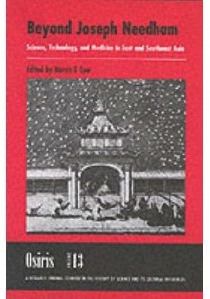Elvin, Mark. “Who Was Responsible for the Weather? Moral Meteorology in Late Imperial China,” in Beyond Joseph Needham: Science, Technology and Medicine in East and Southeast Asia, Osiris, 2nd Series, Volume 13 (University of Chicago Press, 1998), 213-237
Elvin presents this article as the first study in English about a belief, prevalent in Qing imperial decrees, that drought and other disasters were the response of Heaven to human behavior: specifically that disasters were the result of human immorality. This belief in natural responsiveness to human morality, also known more broadly as gan’ying (感応 Jp. kan’ō), dates to Book of Documents and other pre-imperial texts. Elvin focuses not on gan’ying per se, nor on the roots of what he calls “moral meteorology,” but instead on an elaborated model of metaphysical responsibility for disaster that had a brief heyday in the mid-Qing court; specifically, during the reign of the Yongzheng emperor (1723-1736).
“Moral meteorology” under the Yongzheng emperor was used as a technique of moral control, as the human actions that triggered miraculous responses were not limited to those of the emperor himself: ministers, local officials, and particularly the popular masses could, in their good or bad behavior, be the root cause of a disaster. In particular, the instance of the theory that Elvin is examining focuses on the importance of attitude and spiritual orientation, providing a lot of leeway whereby its proponents could explain why disasters occurred even when human actions might seemed objectively correct. This allowed the ruler to not only escape responsibility, but also to use disasters as a chance to correct what he saw as persistent moral problems within the population. However, the “moral meteorology” theory also had to compete with other theories of disaster, including those that predicted good or bad weather by numerological methods. These alternative theories, along with environmental conditions—Elvin notes that the theory could only arise in northern China, when rainfall was variable enough to seem responsive to human activity—led to the theory’s declining and less vigorous use in imperial rhetoric after the Yongzheng reign.
Elvin is in his text frankly dismissive of the “moral meteorology” theory, particularly as it was formulated by Yongzheng, describing it as “tortuous nonsense,” (page 237) and rife with “contradictions that [the emperor] could only wish away by the force of authority” (page 224) that emerge when the theory is placed in an empirical or even protoscientific context. Yet the “moral meteorology” aspect of gan’ying theory has had remarkable staying power—the same rhetoric Yongzheng and other Qing emperors employed was present in Tokyo Governor Ishihara’s notorious remarks following the Tōhoku disaster.
The theory of “moral meteorology” is a realm where, for the study of premodern Asia, the history of science and the history of Asian religions meet; yet its persistence in modern political rhetoric should not be read as a case of religious beliefs persisting in the face of modern science. As scholars of religion have noted, mainstream religious organizations can and do reject such explanations of disaster (McLaughlin 2011). Therefore, the persistence and rhetorical power of “moral meteorology” and related ways of framing and explaining disaster cannot be simply a case of religious versus scientific explanations, and the subject requires further attention. Elvin’s article provides a valuable introduction to the subject, examined within its native imperial Chinese habitat, which should launch discussion and deeper study of this rhetorical style.
Related:
McLaughlin, Levi. “Tokyo Governor Says Tsunami is Divine Punishment—Religious Groups Ignore Him,” Religion Dispatches, March 17, 2011, http://www.religiondispatches.org/archive/politics/4399/tokyo_governor_says_tsunami_is_divine_punishment_religious_groups_ignore_him
Kristina Buhrman, Florida State University
![[Teach311 + COVID-19] Collective](https://blogs.ntu.edu.sg/teach311/files/2020/04/Banner.jpg)
